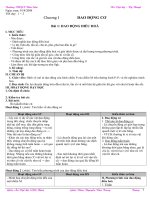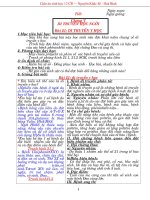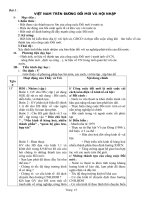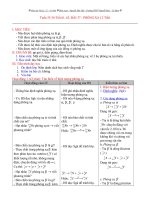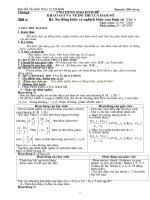giáo án 12cb
Bạn đang xem bản rút gọn của tài liệu. Xem và tải ngay bản đầy đủ của tài liệu tại đây (82.16 KB, 10 trang )
Trờng THPT Nguyễn Thiện Thuật Tiếng Anh 12 GV: Lê Anh Th
UNIT NINE: DESERTS
Date: 1
st
lesson. Reading
55
th
period.
A) Aims. To help Ss practise reading a passage about deserts.
B) Objectives. By the end of the lesson, Ss will be able to understand the passage about deserts
and scan for specific details.
C) Materials. Textbook, handouts.
D) Methods. Integrated, mainly communicative.
E) Anticipated problems. Ss maynot be familiar with the topic.
F) Procedure.
Time Teachers activities Students activities
3
minutes
10
minutes
I) Warm up: Fill in the blank with the most suitable word.
+ A ________ is a hot, dry sandy place.
- Ask Ss to work in groups then read aloud the answers.
- Write the answers on the board then give the suggested answer.
=> Lead in the new lesson: DESERTS.
II) New lesson.
* Before you read.
- Ask Ss to look at the pictures then answer some questions.
- Ask Ss to read aloud then call others to give remarks.
- Give corrective feedback if necessary.
1. Deserts are the large areas of sand without tree and water, but
with severe climates, very hot during day and very cold at night.
There is very little rainfall there; very few people and animals live
except for in oases.
2. In a desert, only cacti and a kind of spinifex can grow. No kind
of animals can live in deserts.
3. Australia, Mongolia, The USA, and in north Africa have deserts.
* Newwords.
+ Stretch (n) dải đất [stret] + Stretch (v) Kéo dài
+ comprise (v) bao gồm [km'praiz]
+ enormous (a) Khổng lồ [i'n:ms]
+ explore (v) Thăm dò [iks'pl:]
+ aerial (a) Trên không ['eril]
+ expedition (n) Cuộc, đoàn thám hiểm [,ekspi'din]
+ dune (n) cồn cát [dju:n] + loose (a) mềm, xốp [lu:s]
+ Hummock (n) gò đống ['hmk] + crest (n) đỉnh, ngọn [krest]
+ spinifex (n) cỏ lá nhọn + corridor (n) Hành lang ['krid:]
+ stable (a) ổn định, vững chắc ['steibl]
+ slope (n) sờn dốc [sloup]
+ shrubland(n) vùng đất có cây bụi [rb]
+ Steep(a) dốc, (n) sờn dốc [sti:p]
*While you read.
* Task 1. Give the meaning of the words.
- Ask Ss to read through the passage first then read task 1
carefully.
- Ask Ss to read the passage again and pay attention to the words.
- Ask Ss to read aloud the meaning of the words then give remarks
- Work in groups.
- Read aloud the
answers then copy.
- Look at the
pictures then work
in groups.
- Read aloud the
answers then copy.
- Find out
newwords.
- Work in groups
then read aloud.
- 1 -
Trêng THPT NguyÔn ThiÖn ThuËt – TiÕng Anh 12 GV: Lª Anh Th
20
minutes
10
minutes
2
minutes
if necessary.
* Task 2. Decide whether the statements are true or false.
- Ask Ss to read task 2 carefully and find out keywords.
- Ask Ss to read through the passage again to find out the answers
- Ask Ss to work in groups then read aloud the answers.
- Ask others to give remarks then gve corrective feedback.
1. False 2. False 3. True 4. False 5. False 6. True
* Task 3. Answer the following questions.
- Ask Ss to read through task 3 and find out keywords.
- Ask Ss to read the passage again to find out the answers.
- Ask Ss to work in pairs then read aloud the questions and
answers.
- Go around and offer help if necessary.
- Ask others to give remarks then give corrective feedback.
1. They are Great Victoria Deserts, Gibbon, Great Sandy and
Tanami Deserts and Simpson Desert.
2. It lies between Lake Eyre in the south, the Macdonnel Ranges
in the north, the Mulligan and the Diamantina Rivers in the east,
and the Macumba and Finke Rivers in the west.
3. In 1845.
4. He was the President of the South Australian Branch of the
Royal Geographical Society of Australia.
5. They took camels across the desert.
6. In the western part, they are short, mostly less than 10 metres
high, and in the northern part, they are parallel and are up to 20
metres high.
7. Two. They are hummock glasses and spinifex.
* After you read.
- Ask Ss to work in groups then answer the questions.
- Go around and offer help if necessary.
- Ask Ss to read aloud the answers then call others to give remarks.
- Ask Ss to read aloud then translate the story into vietnamese.
- Ask Ss to retell the story if there is enough time.
1. Yes, it is.
2. It is the interpreter’s pronunciation. He pronounced the word
“dessert” wrongly, which made the American businesman
misunderstand him. That’s really a great pity or shame.
III) Homework assignment.
Ask Ss to prepare “ Speaking” in advance.
- Give remarks then
copy.
- Work in groups
then read aloud.
- Give remarks then
copy.
- Work in groups
then read aloud.
- Give remarks then
copy.
- Work in groups
then read aloud.
- Give remarks then
copy.
UNIT NINE: DESERTS
- 2 -
Trêng THPT NguyÔn ThiÖn ThuËt – TiÕng Anh 12 GV: Lª Anh Th
Date: …………… 2
nd
lesson. Speaking
56
th
period.
A) Aims. To help Ss practise speaking about deserts.
B) Objectives. By the end of the lesson, Ss will be able to talk about natural features of deserts
and desert life, and express their ideas about related matters.
C) Materials. Textbook, handouts.
D) Methods. Integrated, mainly communicative.
E) Anticipated problems. Ss maynot be familiar with the topic.
F) Procedure.
Time Teacher’s activities Students’ activities
3
minutes
15
minutes
10
I) Warm up: Listen and write down the words you have just
heard.
+ grass, goat, sheep, buffalo, banana, camel, horse, date palm,
cactus.
- Check and give the answers.
- Ask Ss to answer some questions.
T: Which animal and plant can’t live in the desert?
S: buffalo, banana, horse
T: Why?
S: They can’t stand the heat and need a lot of water.
=> Lead in the new lesson: LIFE IN THE DESERT.
II) New lesson.
* Task 1. Check the list then give your opinion about it.
- Ask Ss to read through the task and go around to offer help if
necessary.
- Help Ss read aloud the words and correct their mispronunciation
if necessary.
- Give Ss some useful expressions.
+ What kinds of trees and animals on this list do you think might
exist in the desert?
+ Why?
+ How come?
+ What about ?………
* Ask 2 good Ss to make an example using the sugestions
A: What kinds of trees and animals on this list do you think might
exist in the desert?
B: I think date palms, cactus, grass, camels, and lizards can exist
in the desert because they don’t need a lot of water and can survive
under difficult conditions.
A: What about banana trees?
B: I don’t think they can live in such hot weather. Moreover, we
have never seen banana trees in pictures taken in deserts, have we?
- Ask Ss to work in pairs and go around to offer help if necessary.
- Ask Ss to read aloud their dialogues then call others to give
remarks.
- Give corrective feedback if necessary.
* Task 2. Find out as many natural features of a desert as
possible.
- Work in
individuals.
- Read aloud then
give remarks.
- Answer the
questions.
- Copy.
- Work in groups
then read aloud.
- Give remarks then
copy.
- 3 -
Trêng THPT NguyÔn ThiÖn ThuËt – TiÕng Anh 12 GV: Lª Anh Th
minutes
15
minutes
2
minutes
-Help Ss by giving them some expressions.
+ What do you know about ?…………
+ It is said that ..…………
+ It says in the books that ..……………
- Ask Ss to read aloud then call 2 good Ss to make an example.
A: What do you know about the climate in the desert?
B: It is said that it’s very hot in the daytime but it is very cold at
night.
A: I see, but it says in the books that there are some cold deserts
where it is very cold at some time of the year.
B: And please tell me about the rainfall. How often does it rain
here?
A: It rarely rains there so everything is very dry.
B: Are there 4 seasons in the desert?
A: I am not sure but as far as I can remember in some cold deserts
there are hot summers and very cold winters.
- Ask Ss to work in pairs then go around to offer help if necessary
- Ask Ss to read aloud then give corrective feedback if necessary.
* Task 3. Make a dialogue with your friend.
- Ask Ss to work in groups and go around to offer help if
necessary.
+ What are five things you should bring with you if ..?………
+ And what about + N ?
+ Would you need + N?
+ And what else would you need?
+ Why don’t you bring + N?
- Ask Ss to read aloud the dialogues then call others to give
remarks.
- Give corrective feedback if necessary.
A: What are five things you should bring with you if you are going
on an expedition across the desert?
B: I think I should bring a knife in case I need food to eat. It is also
used to protect me from the attack of dangerous animals or bad
people.
A: And what about a mosquito net? Would you need one?
B: Oh no. I would have a face net and clothes long enough to cover
my whole body.
A: And what else would you need?
B: Food is the next thing because it is very difficult to find food in
the desert. I think we should bring as much food as possible
because we could get stuck there.
A: Why don’t you bring a cell phone? It could be very helpful if
you got lost. Someone could come and rescue you.
B: Are you joking? Do you think there would be telephone waves/
signals in the desert? And how can we charge the battery?
III) Homework assignment.
Ask Ss to prepare “Listening” in advamce
- Work in groups
then read aloud.
- Give remarks then
copy.
- Work in groups
then read aloud.
- Give remarks then
copy.
UNIT NINE: DESERTS
- 4 -
Trêng THPT NguyÔn ThiÖn ThuËt – TiÕng Anh 12 GV: Lª Anh Th
Date: …………… 3
rd
lesson. Listening
57
th
period.
A) Aims. To help Ss practise listening about deserts.
B) Objectives. By the end of the lesson, Ss will be able to listen for the understanding of the
passage and listen for specific details.
C) Materials. Textbook, handouts.
D) Methods. Integrated, mainly communicative.
E) Anticipated problems. Ss maynot be familiar with the topic.
F) Procedure.
Time Teacher’s activities Students’ activities
3
minutes
10
minutes
I) Warm up: - Complete the following sentence with your own
words.
+ A desert is a place____________________________.
- Ask Ss to work in groups then read aloud the anwers.
- Call others to give remarks and correct if necessary.
+ where there are no roads, buildings, cars, rivers.
+ where it is hard to live.
+ where it’s very hot during the daytime but very cold at night.
Lead in the new lesson. DESERTS – what they are and
how they are formed.
II) New lesson.
* Before you listen.
- Ask Ss to open their book then answer all the questions in the
textbook.
- Ask Ss to work in pairs then read aloud the answers.
- Correct their mistakes if necessary.
1. A desert is a large area of land where it is always very hot and
dry and there is a lot of sand.
2. A desert can be formed by various cases, the major of which is
global climatic change. The second cause is the misutilisation of
land by humans such as poor land management and poor water
management and the deforestation.
3. Yes, They can make a desert by the misutilisation of land, and
by the deforestation or overcultivation and incorrect irrigation
methods.
* Listen and repeat. – Ask Ss to read the words in silence then
listen to the tape the first time.
- Ask Ss to read after the tape then read aloud.
- Correct their mispronunciation and give them the meaning of the
words if necessary.
+ Sahara (n) [sə'hɑ:rə] + firewood (n) cñi ['faiəwud]
+ petroleum (n) dÇu má [pə'trouliəm] + Mauritania (n)
+ needle (n) l¸ kim 'ni:dl] + colony (n) thuéc ®Þa ['kɔləni]
* While you read.
* Task 1. Listen and find out the sentences are true or false.
- Ask Ss to read the sentences carefully then guess the answers.
- Ask Ss to read aloud the answers then write on the board.
- Ask Ss to listen to the tape then work in groups to check their
- Work in
individuals.
- Read aloud then
give remarks.
- Copy.
- Work in groups.
- Read aloud the
answers.
- Give remarks.
- Copy.
- Work in groups.
- Guess the
answers.
- Listen then read
- 5 -


